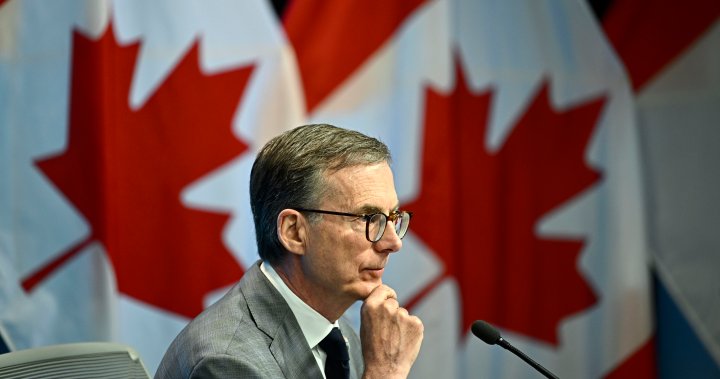The Bank of Canada is set to deliver its next interest rate decision on Wednesday as many economists and market watchers expect a second consecutive cut in borrowing costs.
The central bank’s hotly-anticipated decision comes as new polling shows Canadians struggling with debt loads are clamouring for interest rate relief.
As of Monday, market odds were almost fully pricing in a 25-basis-point interest rate cut this week that would bring the benchmark rate down to 4.5 per cent.
That comes after the Bank of Canada last month delivered its first rate cut in more than four years. Tiff Macklem, the head of the central bank, said then that Canadians can expect a gradual pace of rate cuts going forward, with monetary policymakers watching the data carefully heading into each rate meeting.
It was the latest inflation data from June released last week that “sealed the deal” for another rate cut on Wednesday, according to Benjamin Reitzes, managing director of Canadian rates and macro strategist at BMO.
After a slight bump in Statistics Canada’s inflation reading for May, price pressures showed signs of easing again in June, coming in at 2.7 per cent annually. Core inflation, closely watched by the Bank of Canada, also showed some signs of cooling.

In addition to good news on the inflation front, the Bank of Canada has seen further signs of slowing in the Canadian labour market and retail sales, which Reitzes said in a brief note Monday should give the central bank confidence that economic conditions are right for further price cooling.
“That gives the (Bank of Canada) a big green light to cut this week,” he wrote.
Jeremy Kronick, associate vice-president and director of the Centre on Financial and Monetary Policy at the CD Howe Institute, is also in the camp for a rate cut on Wednesday.
He tells Global News that while there are some warning flags remaining on the inflation front — wage growth remains hot and some measures of core inflation are holding stubborn — the Bank of Canada is likely to look past individual markers to show enough of a “softening” to warrant lower interest rates.
Financial news and insights
delivered to your email every Saturday.

Get weekly money news
Get expert insights, Q&A on markets, housing, inflation, and personal finance information delivered to you every Saturday.
“That’s what the Bank’s job is, to not look at it today, but look at where it’s going,” he says. “And I think all of it points towards the current policy being restrictive such that they can continue to cut.”
Two-thirds of Canadians ‘desperately’ need rate cuts: poll
The Bank of Canada’s policy rate broadly sets the cost of borrowing across the country, informing rates on loans like Canadian mortgages.
The latest MNP Consumer Debt Index released on Monday shows that many Canadians are not feeling good about their debt loads despite a single rate cut last month.
The index, based on quarterly polling from Ipsos, dropped to 85 in the second quarter, down six points from the previous iteration. Downward moves in the debt index suggest negative perceptions about Canadians’ debt.
Two-thirds (66 per cent) of those surveyed said they “desperately need interest rates to go down.”
More than half (56 per cent) said that interest rates may not fall quickly enough to provide financial relief, while a similar number (57 per cent) said they would need interest rates to go down “a lot” before their finances would improve.
The poll surveyed some 2,000 Canadains adults online between June 6 and 11, after the Bank of Canada’s initial rate cut.
Kronick says that another rate reduction on Wednesday would matter most to Canadians with variable mortgage payments that rise and fall in line with the central bank’s benchmark rate.

For Canadians with a fixed-rate mortgage, many of whom have renewals looming in the months ahead, Wednesday’s decision might not have as much of a direct impact. Fixed mortgage rates, typically the most popular option in Canada, are derived from movements in the bond market, which are already pricing in future interest rate cuts from the central bank.
A rate cut may not be “hugely impactful in the moment” for many Canadian mortgage holders without variable payments, Kronick says.
But whether the central bank is delivering cuts at every meeting or alternating with holds, Kronick says easing in the economy should show the path is clear for rates going forward.
“Absent a major, major shock, I still would expect that rates are going to continue to fall. Really, the pace is the question,” he says.
That’s good news for Canadians bracing for the impact of upcoming mortgage renewals.
“I think it’ll be better for those that will anticipate a big sticker shock from their renewals,” Kronick says.
On BMO’s part, Reitzes said he expects additional rate cuts in October and December, leaving the Bank of Canada’s policy rate at an even 4.0 per cent heading into 2025.
Kronick says that while the Bank of Canada has room to keep cutting while holding in a “restrictive” stance, he expects the central bank policymakers will remain “cautious” in the latter months of the year, watching for progress on core inflation and wage growth before lowering much further.
In addition to the rate decision, the Bank of Canada will release updated economic outlooks on Wednesday forecasting the path back to its two-per cent inflation goal and revised expectations for growth in the economy.

© 2024 Global News, a division of Corus Entertainment Inc.





